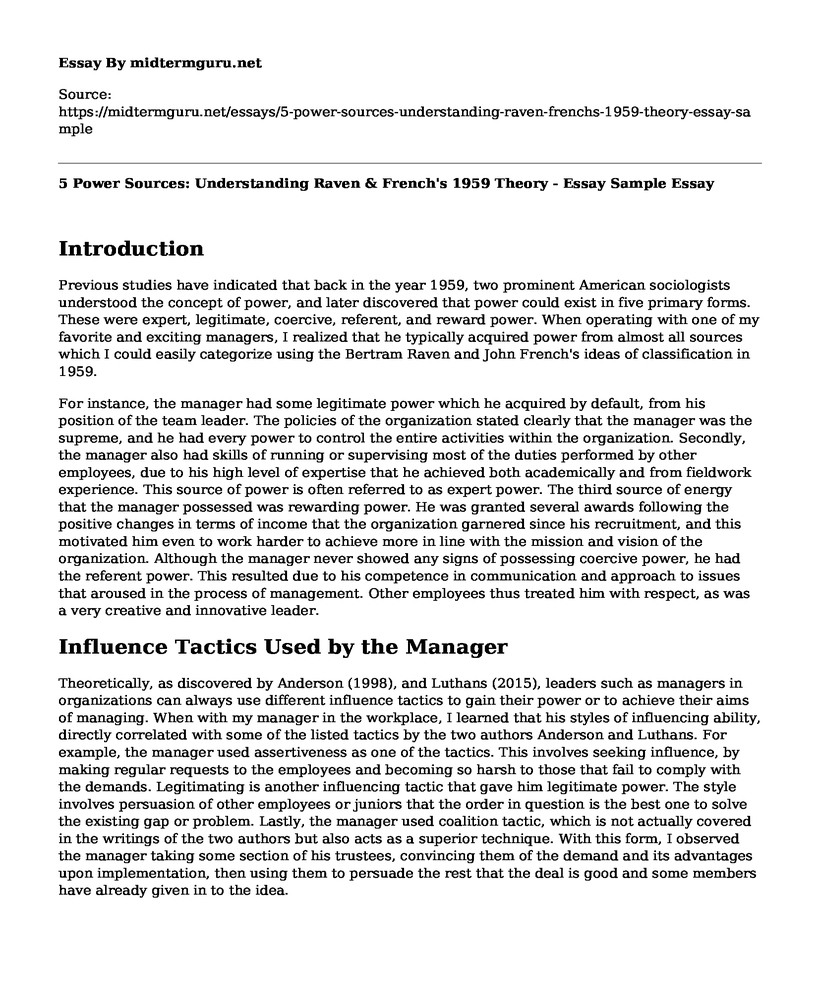Introduction
Previous studies have indicated that back in the year 1959, two prominent American sociologists understood the concept of power, and later discovered that power could exist in five primary forms. These were expert, legitimate, coercive, referent, and reward power. When operating with one of my favorite and exciting managers, I realized that he typically acquired power from almost all sources which I could easily categorize using the Bertram Raven and John French's ideas of classification in 1959.
For instance, the manager had some legitimate power which he acquired by default, from his position of the team leader. The policies of the organization stated clearly that the manager was the supreme, and he had every power to control the entire activities within the organization. Secondly, the manager also had skills of running or supervising most of the duties performed by other employees, due to his high level of expertise that he achieved both academically and from fieldwork experience. This source of power is often referred to as expert power. The third source of energy that the manager possessed was rewarding power. He was granted several awards following the positive changes in terms of income that the organization garnered since his recruitment, and this motivated him even to work harder to achieve more in line with the mission and vision of the organization. Although the manager never showed any signs of possessing coercive power, he had the referent power. This resulted due to his competence in communication and approach to issues that aroused in the process of management. Other employees thus treated him with respect, as was a very creative and innovative leader.
Influence Tactics Used by the Manager
Theoretically, as discovered by Anderson (1998), and Luthans (2015), leaders such as managers in organizations can always use different influence tactics to gain their power or to achieve their aims of managing. When with my manager in the workplace, I learned that his styles of influencing ability, directly correlated with some of the listed tactics by the two authors Anderson and Luthans. For example, the manager used assertiveness as one of the tactics. This involves seeking influence, by making regular requests to the employees and becoming so harsh to those that fail to comply with the demands. Legitimating is another influencing tactic that gave him legitimate power. The style involves persuasion of other employees or juniors that the order in question is the best one to solve the existing gap or problem. Lastly, the manager used coalition tactic, which is not actually covered in the writings of the two authors but also acts as a superior technique. With this form, I observed the manager taking some section of his trustees, convincing them of the demand and its advantages upon implementation, then using them to persuade the rest that the deal is good and some members have already given in to the idea.
Discussion
Basically, the manager in his organization was brilliant as his pick to given tactics of influencing other employees, in the process of gaining power remained positive and frequently led no disagreements and internal fights within the organization. For instance, he introduced motivations to the employees to motivate them of their excellent work and also to show them that they were recognized by the management. The motivations also included elevating hard-working employees to higher levels in terms of power or salaries. Besides, there is no moment that he mistreated or harassed any worker. In most organization, some leaders use coercive power to rule their subjects. However, the manager never did.
References
Case, T., Dosier, L., Murkison, G., & Keys, B. (1988). How managers influence superiors: A study of upward influence tactics. Leadership & Organization Development Journal, 9(4), 25-31. Retrieved from https://www.emeraldinsight.com/doi/abs/10.1108/eb053641
Finstad, C. (2011). Organizational commitment through organizational socialization tactics. Journal of Workplace Learning, 23(6), 376-390. Retrieved from https://www.emeraldinsight.com/doi/abs/10.1108/13665621111154395
Pfeffer, J., & Pfeffer, J. (1981). Power in organizations (Vol. 33). Marshfield, MA: Pitman.
Cite this page
5 Power Sources: Understanding Raven & French's 1959 Theory - Essay Sample. (2023, Feb 11). Retrieved from https://midtermguru.com/essays/5-power-sources-understanding-raven-frenchs-1959-theory-essay-sample
If you are the original author of this essay and no longer wish to have it published on the midtermguru.com website, please click below to request its removal:
- History, Development, and Growth of the Toy-R-US Company Over Time - Paper Example
- Forecasting Case Study Paper Example: Urban Planning
- Essay on Corporate Social Responsibility and Ethical Decision Making
- The Effect of Business Ethics in Improving the Productivity in a Business Organization - Paper Example
- Essay Sample on Leadership and Collaboration Experience
- Prostay Ltd: Quality Products, Rising Market Share, & Customer Satisfaction - Essay Sample
- L-Choco: Targeting Adults & Children for Online & Offline Marketing - Essay Sample







